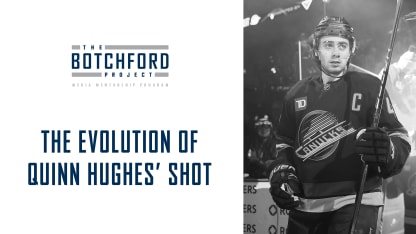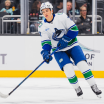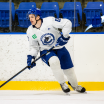Tyson Cole - @SpittinPicklets
The 2023-2024 season has been an eventful one for Quinn Hughes.
On opening night, Hughes was honoured as the 15th captain in Vancouver Canucks history. The seventh overall pick in the 2018 NHL Entry Draft has taken the challenge and excelled with the added pressure of being a captain in a Canadian market.
Captaincy is not the only new quality Hughes has brought to the ice this year. The young defenceman has been experimenting with his shot, and it's been turning heads. Hughes is now showing that he offers much more than just his elite playmaking ability.
Not only can the hockey world visually see the progression of Hughes' shot, but data provided by NHL Edge further illustrates the numbers behind the excellence that has emerged.
Quinn Hughes Previous Career Highs
Average Shot Speed: 64.98 miles per hour.
Shots On Goal: 154 shots (2022)
Shot Attempts: 368 shot attempts (2022)
Shooting Percentage: 6.4% (2019)
Goals: Eight goals (2019 & 2021)
Quinn Hughes Current 2023 Stats
Average Shot Speed: 66.04 miles per hour.
Shots On Goal: 100 shots. On pace for 200 shots.
Shot Attempts: 269 shot attempts. On pace for 538 shot attempts.
Shooting Percentage: 11.0%
Goals: 11 goals. On pace for 22 goals.
The usually self-deprecating defenceman couldn't help but show emotion, sharing a subtle smirk when being made aware of the numbers behind the elite-level shooting pace he is on.
When asked what he worked on in the off-season to improve his shot, he replied, "Nothing too much, just trying to get in spots where I can score more, not just being on the blue line, being a little bit lower."
Comparing his shot location on NHL Edge, you can see he's stuck to that strategy this season.
Last season, of his 149 shots on goal tracked, 61% of them came from the blue line, leaving only 39% of his shots coming from the medium-high danger areas.
This season, of his 100 shots on goal tracked, 42% of them came from the blue line, leaving 58% of his shots coming from the medium-high danger areas.
Hughes has maintained what he worked on this offseason, as the fanbase is seeing a 19% increase in shots on goal in higher-danger scoring areas. This modification of his game has been a key contributor to the boost of the Canucks scoring chances this season.
The University of Michigan product has showcased his new shooting technique with different movements, so he doesn't have to stop his momentum when skating. This alteration to his game has increased his average shot speed, and he's finding himself in more comfortable positions to get a high-quality shot on the net.
"A lot of times I'd beat a guy, and then I couldn't get away from him to have enough room to shoot, and now I can do it with fluidity and my stride to get myself in a shooting position," Hughes explained.
Canucks fans have seen how Hughes has utilized this move already, breaking his single-season goal record in just twenty-five games. Seven of his 11 goals have come from below the top of the circle. Four of these goals have been from attacking the net from the left side of the offensive zone.
It's not just the fanbase and hockey viewers who are taking note of Hughes' new approach; teammate Elias Pettersson commented on how Hughes is using the downhill side to attack goaltenders. "Whenever he has the puck, he's constantly looking to make a play. He's definitely got a big arsenal with a lot of moves."
Canucks head coach Rick Tocchet echoed Pettersson’s sentiments and has been encouraged by his star defenceman being more aggressive and taking more shots this season. "He's developed his shot. His shot is so much better than last year. He worked on his game."
"I'd be around the net when you're playing with Quinn Hughes,” said Tocchet. “Whoever plays with Quinn, if you're a forward, get to the net or be ready for a shot-pass."
Team Success
Hughes' rise in shot volume has been a catalyst for the team's impressive start. The Canucks are having their best first half of a season based on points percentage since 2010-2011.
"There's not as much pressure," Hughes replied when asked if the team's fast start has given him the confidence to shoot the puck more. "We're playing good hockey and in the offensive zone more. Having a defensive partner like Filip Hronek also gets me the puck more and gives me two or three more chances and good looks per game. Having a partner like him gives me more touches and more opportunities to make a play."
This Hughes-Hronek pairing ranks as the most dangerous offensive pairing in the league. The duo is first in goals for when on the ice, first in points as a pairing and first in high-danger scoring chances amongst all pairings.
Norris Trophy Candidacy
The Florida native leads all defencemen with 51 points and a +32 in 41 games. He’s also second in the league for goals from a defenceman with 11. After receiving one first-place vote last year Hughes is making an even stronger case for Norris Trophy consideration this season.
Hughes is on pace for 22 goals, 80 assists, 102 points and a +64. Last year's Norris trophy winner, Erik Karlsson, finished with 25 goals, 76 assists, and 101 points but a -26.
Currently the odds-on favourite to win the award, Hughes is producing comparable numbers to Karlsson, who received 80% of all first-place votes. While sustaining this high level of production over the remainder of the season seems unlikely, he's shown no signs of slowing down over the first 41 games.
This year has been one to remember for the Hughes family. With the statistics Quinn has put up and is currently on pace for, he could insert himself in the record books with one of the best single seasons by a defenceman in NHL history.
Hughes has taken advantage of his reformed shot as it acts as a new tool in his bag. The mechanics he's taught himself over the offseason are translating to the very successful product hockey fans are seeing on the ice and a vital part in the early success of the Vancouver Canucks this season.



















